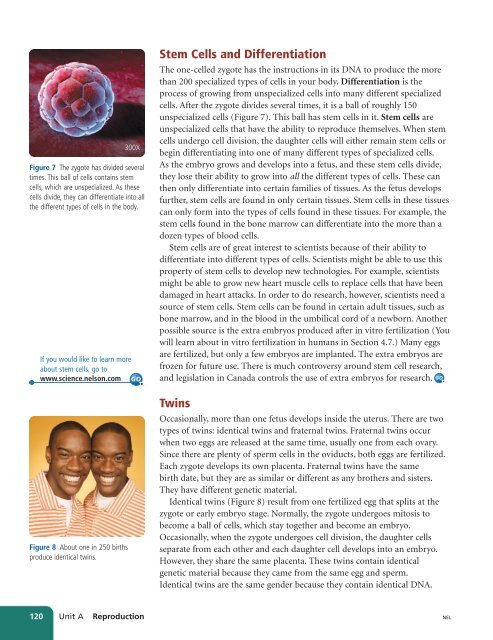Unit A Reproduction
Unit A Reproduction
Unit A Reproduction
You also want an ePaper? Increase the reach of your titles
YUMPU automatically turns print PDFs into web optimized ePapers that Google loves.
Figure 7 The zygote has divided several<br />
times. This ball of cells contains stem<br />
cells, which are unspecialized. As these<br />
cells divide, they can differentiate into all<br />
the different types of cells in the body.<br />
Figure 8 About one in 250 births<br />
produce identical twins.<br />
300X<br />
If you would like to learn more<br />
about stem cells, go to<br />
www.science.nelson.com GO<br />
Stem Cells and Differentiation<br />
The one-celled zygote has the instructions in its DNA to produce the more<br />
than 200 specialized types of cells in your body. Differentiation is the<br />
process of growing from unspecialized cells into many different specialized<br />
cells. After the zygote divides several times, it is a ball of roughly 150<br />
unspecialized cells (Figure 7). This ball has stem cells in it. Stem cells are<br />
unspecialized cells that have the ability to reproduce themselves. When stem<br />
cells undergo cell division, the daughter cells will either remain stem cells or<br />
begin differentiating into one of many different types of specialized cells.<br />
As the embryo grows and develops into a fetus, and these stem cells divide,<br />
they lose their ability to grow into all the different types of cells. These can<br />
then only differentiate into certain families of tissues. As the fetus develops<br />
further, stem cells are found in only certain tissues. Stem cells in these tissues<br />
can only form into the types of cells found in these tissues. For example, the<br />
stem cells found in the bone marrow can differentiate into the more than a<br />
dozen types of blood cells.<br />
Stem cells are of great interest to scientists because of their ability to<br />
differentiate into different types of cells. Scientists might be able to use this<br />
property of stem cells to develop new technologies. For example, scientists<br />
might be able to grow new heart muscle cells to replace cells that have been<br />
damaged in heart attacks. In order to do research, however, scientists need a<br />
source of stem cells. Stem cells can be found in certain adult tissues, such as<br />
bone marrow, and in the blood in the umbilical cord of a newborn. Another<br />
possible source is the extra embryos produced after in vitro fertilization (You<br />
will learn about in vitro fertilization in humans in Section 4.7.) Many eggs<br />
are fertilized, but only a few embryos are implanted. The extra embryos are<br />
frozen for future use. There is much controversy around stem cell research,<br />
and legislation in Canada controls the use of extra embryos for research. GO<br />
Twins<br />
Occasionally, more than one fetus develops inside the uterus. There are two<br />
types of twins: identical twins and fraternal twins. Fraternal twins occur<br />
when two eggs are released at the same time, usually one from each ovary.<br />
Since there are plenty of sperm cells in the oviducts, both eggs are fertilized.<br />
Each zygote develops its own placenta. Fraternal twins have the same<br />
birth date, but they are as similar or different as any brothers and sisters.<br />
They have different genetic material.<br />
Identical twins (Figure 8) result from one fertilized egg that splits at the<br />
zygote or early embryo stage. Normally, the zygote undergoes mitosis to<br />
become a ball of cells, which stay together and become an embryo.<br />
Occasionally, when the zygote undergoes cell division, the daughter cells<br />
separate from each other and each daughter cell develops into an embryo.<br />
However, they share the same placenta. These twins contain identical<br />
genetic material because they came from the same egg and sperm.<br />
Identical twins are the same gender because they contain identical DNA.<br />
120 <strong>Unit</strong> A <strong>Reproduction</strong><br />
NEL

















